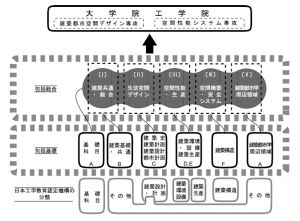北海道大学環境社会工学科建築都市コースは,「北方圏に適応する生活,文化を科学的に究明するとともに,有能な建築技術者を養成する」ことを目的として,1948年に建築工学科の名称で開設され,1997年に建築都市学科と改称,2005年から環境社会工学科建築都市コースと改称されました。
本コースの教育目標は,専門的知識や能力を備えた高度な総合的建築教育を実施し,卒業後の広範な社会的活躍のために,また大学院での専門的な教育・研究展開のための基礎固めを行うことにあります。また本コースは,北海道大学の建学精神,即ち,「フロンティア精神」,「国際性の涵養」,「全人教育」,「地域性および実学の重視」という教育理念を尊重し,本学の置かれた地理的・物理的・社会的環境を積極的に生かした教育を実践することを心掛けています。
本コースは,2003年度に日本技術者教育認定機構(JABEE)の認定を受け,2008年度に認定継続を行いました。この機構によって認定された教育プログラムを受けた本コースの卒業生は,建築学およびその関連分野の基礎教育を受けた技術者であると,国内だけではなく国際的にも認められたことを意味します。JABEE認定プログラム修了者(卒業生)は技術士認定試験の一次試験を免除され,また本学科の出身者が建築・都市学の技術者として国際的に活躍する際のパスポートの役割を果たすことにもなります。
本コース卒業生の8割以上が大学院へ進学しています。本学大学院の建築都市空間デザイン専攻と空間性能システム専攻に進学する者が多数を占めますが,他大学の建築系大学院への進学者もいます。学部卒業生および大学院修了生は社会に出て建築都市に関わる様々な分野で活躍しております。当コースの設立時からの伝統を大切にしながらも,新たな提案を積極的に発信する彼らを輩出したことを教職員一同誇りに思うとともに,今後も社会における指導的人材の養成を心がけていきたいと思います。
“Course of Architecture and Urban Studies, Department of Environmental and Social Engineering”, Hokkaido University was originally established in 1948, as the name of “Department of Architecture” to scientifically investigate life and culture adapted to the northern region and to train skilled architectural engineers”. In 2005, it was renamed Course of Architecture and Urban Studies in the Department of Environmental and Social Engineering.
The educational goal of this course is to provide a comprehensive architectural education to foster high-trained professionals for practical and theoretical activities. In addition, this course respects the educational philosophy of the founding spirit of Hokkaido University, namely “frontier spirit,” “cultivation of internationality,” “education for all,” and “emphasis on regionalism and practical learning.” in implementing our geographical, physical, and social environment.
This course was accredited by the Japan Accreditation Board for Engineering Education (JABEE) in 2003, and the accreditation was renewed in 2008. Graduates of the JABEE accredited program are recognized both domestically and internationally as engineers with basic education in architecture and related fields. The program also serves as a passport for graduates of the department to work internationally as engineers in architecture and urban studies.
More than 80% of graduates of this course go on to graduate school. The majority of our graduates enter the Department of Architectural and Urban Studies and the Department of Spatial Performance Systems, but some also enter architecture-related graduate schools at other universities. Graduates of the undergraduate and graduate programs are active in various fields related to architecture and urban engineering. We will continue to strive to foster leadership in society.

